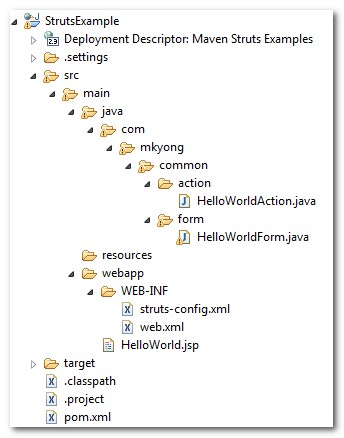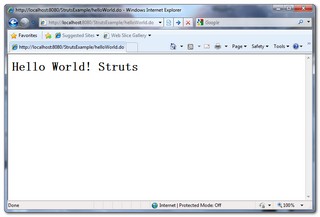Struts Hello World Example
In this tutorial we show you how to develop a hello world web application using classic Struts 1.3 framework.
Tools and technologies used :
- Struts 1.3.10
- Maven 2.x
- Eclipse 3.6
Final project structure
Let’s see the final folder structure first.

1. Maven Template
Generate a quick start Java project structure with Maven command “mvn archetype:generate“, select template 18 for a simple Java web project template.
Define value for groupId: : com.mkyong.common
Define value for artifactId: : StrutsExample
Define value for version: 1.0-SNAPSHOT: :
Define value for package: com.mkyong.common: : com.mkyong.common
...
[INFO] ------------------------------------------------------------------------
[INFO] BUILD SUCCESSFUL
[INFO] ------------------------------------------------------------------------
[INFO] Total time: 1 minute 5 seconds
[INFO] Finished at: Thu Apr 08 11:29:30 SGT 2010
[INFO] Final Memory: 8M/14M
[INFO] ------------------------------------------------------------------------
2. pom.xml file configuration
Add the Struts dependencies in pom.xml. In Struts 1.x, you need the struts-core.jar for core module and struts-taglib.jar for tag library.
<project xmlns="http://maven.apache.org/POM/4.0.0"
xmlns:xsi="http://www.w3.org/2001/XMLSchema-instance"
xsi:schemaLocation="http://maven.apache.org/POM/4.0.0
http://maven.apache.org/maven-v4_0_0.xsd">
<modelVersion>4.0.0</modelVersion>
<groupId>com.mkyong.common</groupId>
<artifactId>StrutsExample</artifactId>
<packaging>war</packaging>
<version>1.0-SNAPSHOT</version>
<name>StrutsExample Maven Webapp</name>
<url>http://maven.apache.org</url>
<dependencies>
<dependency>
<groupId>junit</groupId>
<artifactId>junit</artifactId>
<version>3.8.1</version>
<scope>test</scope>
</dependency>
<dependency>
<groupId>org.apache.struts</groupId>
<artifactId>struts-core</artifactId>
<version>1.3.10</version>
</dependency>
<dependency>
<groupId>org.apache.struts</groupId>
<artifactId>struts-taglib</artifactId>
<version>1.3.10</version>
</dependency>
</dependencies>
<build>
<finalName>StrutsExample</finalName>
</build>
</project>
3. Eclipse IDE
Convert this project to Eclipse web project with Maven command “mvn eclipse:eclipse -Dwtpversion=1.5“. All the Struts dependent libraries will automatically download into your Maven local repository, link it in your project classpath, and convert it to Eclipse’s web project style.
E:\workspace\struts\StrutsExample>mvn eclipse:eclipse -Dwtpversion=1.5
[INFO] Scanning for projects...
[INFO] Searching repository for plugin with prefix: 'eclipse'.
[INFO] ------------------------------------------------------------------------
[INFO] Building StrutsExample Maven Webapp
Just import it into Eclipse IDE.
4. Action Form
Create a Struts Action Form to hold the “hello world” data later.
package com.mkyong.common.form;
import org.apache.struts.action.ActionForm;
public class HelloWorldForm extends ActionForm{
String message;
public String getMessage() {
return message;
}
public void setMessage(String message) {
this.message = message;
}
}
5. Action (Controller)
Create a Struts Action (Action Controller) file to control how Struts will forward the request, just override the execute() method with your own logic here.
package com.mkyong.common.action;
import javax.servlet.http.HttpServletRequest;
import javax.servlet.http.HttpServletResponse;
import org.apache.struts.action.Action;
import org.apache.struts.action.ActionForm;
import org.apache.struts.action.ActionForward;
import org.apache.struts.action.ActionMapping;
import com.mkyong.common.form.HelloWorldForm;
public class HelloWorldAction extends Action{
public ActionForward execute(ActionMapping mapping,ActionForm form,
HttpServletRequest request,HttpServletResponse response)
throws Exception {
HelloWorldForm helloWorldForm = (HelloWorldForm) form;
helloWorldForm.setMessage("Hello World! Struts");
return mapping.findForward("success");
}
}
6. JSP view page
Create a JSP page and access the Action Form object via Struts tag library and print it’s message property.
<%@taglib uri="http://struts.apache.org/tags-bean" prefix="bean"%>
7. struts-config.xml
Create a struts-config.xml file for the Struts configuration details, and put it into the WEB-INF folder.
<?xml version="1.0" encoding="UTF-8"?>
<!DOCTYPE struts-config PUBLIC
"-//Apache Software Foundation//DTD Struts Configuration 1.3//EN"
"http://jakarta.apache.org/struts/dtds/struts-config_1_3.dtd">
<struts-config>
<form-beans>
<form-bean name="helloWorldForm"
type="com.mkyong.common.form.HelloWorldForm"/>
</form-beans>
<action-mappings>
<action path="/helloWorld"
type="com.mkyong.common.action.HelloWorldAction"
name="helloWorldForm">
<forward name="success" path="/HelloWorld.jsp"/>
</action>
</action-mappings>
</struts-config>
Define a form bean named “helloWorldForm” and action controller mapping “HelloWorldAction“, match the /helloWorld web path to HelloWorldAction. It’s means all the request from /helloWorldweb path will redirect toHelloWorldAction. The “name” attribute is use to define which action form will pass to this HelloWorldAction`.
8. The Web Application Deployment Descriptor
In web.xml file, configure the Struts ActionServlet instance and map it with url-pattern “*.do”, so that the container is aware of all the “*.do” pattern will redirect to Struts ActionServlet.
<!DOCTYPE web-app PUBLIC
"-//Sun Microsystems, Inc.//DTD Web Application 2.3//EN"
"http://java.sun.com/dtd/web-app_2_3.dtd" >
<web-app>
<display-name>Maven Struts Examples</display-name>
<servlet>
<servlet-name>action</servlet-name>
<servlet-class>
org.apache.struts.action.ActionServlet
</servlet-class>
<init-param>
<param-name>config</param-name>
<param-value>
/WEB-INF/struts-config.xml
</param-value>
</init-param>
<load-on-startup>1</load-on-startup>
</servlet>
<servlet-mapping>
<servlet-name>action</servlet-name>
<url-pattern>*.do</url-pattern>
</servlet-mapping>
</web-app>
9. Java EE Module dependency (Optional)
If you want to do the debugging work in Eclipse IDE, you have to make sure the Java EE module dependencies is checked so that the Eclipse will deploy all the dependencies into correct folder. See details here.
10. Run it
In Eclipse IDE, create a new server plugin and start it. You can access this example in the following URL.
http://localhost:8080/StrutsExample/helloWorld.do

HttpServletRequest class not found?
If you hit above error, make sure you include the javaee.jar (exists in your JDK/lib folder). Due to license issue, this javaee.jar is not able to use Maven to download it, you have to include it manually.
Struts Hello World Example的更多相关文章
- 菜鸟学Struts2——Struts工作原理
在完成Struts2的HelloWorld后,对Struts2的工作原理进行学习.Struts2框架可以按照模块来划分为Servlet Filters,Struts核心模块,拦截器和用户实现部分,其中 ...
- Struts的拦截器
Struts的拦截器 1.什么是拦截器 Struts的拦截器和Servlet过滤器类似,在执行Action的execute方法之前,Struts会首先执行Struts.xml中引用的拦截器,在执行完所 ...
- Struts框架的核心业务
Struts的核心业务 Struts核心业务有很多,这里主要介绍了比较简单一些的: 请求数据的处理,和数据自动封装,类型自动转换 1.Struts中数据处理 1.1.方式1:直接过去servletap ...
- Struts的文件上传下载
Struts的文件上传下载 1.文件上传 Struts2的文件上传也是使用fileUpload的组件,这个组默认是集合在框架里面的.且是使用拦截器:<interceptor name=" ...
- 配置hibernate,Struts。文件
hibernate文件配置 <?xml version="1.0" encoding="UTF-8"?> <!DOCTYPE hibernat ...
- hibernate与Struts框架结合编写简单针对修改练习
失败页面fail.jsp <%@ page language="java" contentType="text/html; charset=UTF-8" ...
- 3. 解析 struts.xml 文件
1. struts.xml 文件基本配置: 主要放在资源路径下,配置 sturts2相关的 Action , 拦截器等配置 <struts> <!-- 设置常量 --> < ...
- Struts+Spring+Hibernate项目的启动线程
在Java Web项目中,经常要在项目开始运行时启动一个线程,每隔一定的时间就运行一定的代码,比如扫描数据库的变化等等.要实现这个功能,可以现在web.xml文件中定义一个Listener,然后在这个 ...
- Struts 原理
今天开始接触公司的框架,叫YNA,三个字母应该是雅马哈的缩写,这个框架听公司前辈说功能很强大,但实际上我看不懂.哈哈...... 其中整合了SSH框架,接下来我说下Struts的一些原理 其实这张图就 ...
- axis2+struts拦截地址冲突问题
axis2和struts在整合过程中,struts会把axis的地址也拦截了,默认当成一个action处理, 会因为找不到action而报错: <!-- struts配置 --> < ...
随机推荐
- 修改tomcat小猫图标
网站放到网上去了,不喜欢大家访问的时候可以看到tomcat的小猫图标.今天在网上搜了搜,总结一下收藏了. 1.直接找个16*16的ico图片.放到tomcat/root下,取个名叫favicon.ic ...
- Codeforces 435 B Pasha Maximizes【贪心】
题意:给出一串数字,给出k次交换,每次交换只能交换相邻的两个数,问最多经过k次交换,能够得到的最大的一串数字 从第一个数字往后找k个位置,找出最大的,往前面交换 有思路,可是没有写出代码来---sad ...
- BZOJ 2120/BZOJ 2453
分块傻逼题. memset很慢的...而且其实也没有用.... #include<iostream> #include<cstdio> #include<cstring& ...
- DOM对象常用对象的方法和属性
HTML文档中的常用节点类型: 接口 nodeType 备注 Element 1 元素节点 Text 3 文本节点 Document 9 Document Comment 8 注释文本 Docum ...
- JS模块化编程之AMD规范(转)
随着网站逐渐变成"互联网应用程序",嵌入网页的Javascript代码越来越庞大,越来越复杂. 网页越来越像桌面程序,需要一个团队分工协作.进度管理.单元测试等等......开发者 ...
- RIA+REST架构实现完美WEB开发
记得第一次看到REST的身影,是在InfoQ上的一篇介绍,随后又翻阅了后面的参考文章和Developerwork上一些资料,甚至随手翻了翻Roy博士的论文.所幸,在不少人还在体会REST到底是何方神圣 ...
- php查询汉字的拼音首字母的函数
function getfirst($str, $charset='utf8'){ $dict=array( 'a'=>0xB0C4, 'b'=& ...
- Yii入门教程
1准备Yii源码 首先新建helloyii目录作为Web应用的根目录,并添加到Nginx的配置文件中.然后将Yii框架源码部署到helloyii下,目录结构如下: helloyii/ |-- fram ...
- HDU5805 NanoApe Loves Sequence (BestCoder Round #86 B)前后缀预处理
分析:维护空隙的差,然后预处理前缀最大,后缀最大,扫一遍 #include <cstdio> #include <cstring> #include <cmath> ...
- Linux下安装Vapor
1.官网下载Vapor软件(二进制安装文件) 注:注意版本,linux下可以在终端输入-uname -l 查看系统版本 2.cd到Vapor软件所在目录 3.解压:1)gunzip vapor-*** ...
